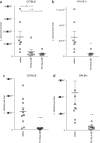A defined subunit vaccine that protects against vector-borne visceral leishmaniasis
- PMID: 29263878
- PMCID: PMC5627294
- DOI: 10.1038/s41541-017-0025-5
A defined subunit vaccine that protects against vector-borne visceral leishmaniasis
Abstract
Vaccine development for vector-borne pathogens may be accelerated through the use of relevant challenge models, as has been the case for malaria. Because of the demonstrated biological importance of vector-derived molecules in establishing natural infections, incorporating natural challenge models into vaccine development strategies may increase the accuracy of predicting efficacy under field conditions. Until recently, however, there was no natural challenge model available for the evaluation of vaccine candidates against visceral leishmaniasis. We previously demonstrated that a candidate vaccine against visceral leishmaniasis containing the antigen LEISH-F3 could provide protection in preclinical models and induce potent T-cell responses in human volunteers. In the present study, we describe a next generation candidate, LEISH-F3+, generated by adding a third antigen to the LEISH-F3 di-fusion protein. The rationale for adding a third component, derived from cysteine protease (CPB), was based on previously demonstrated protection achieved with this antigen, as well as on recognition by human T cells from individuals with latent infection. Prophylactic immunization with LEISH-F3+formulated with glucopyranosyl lipid A adjuvant in stable emulsion significantly reduced both Leishmania infantum and L. donovani burdens in needle challenge mouse models of infection. Importantly, the data obtained in these infection models were validated by the ability of LEISH-F3+/glucopyranosyl lipid A adjuvant in stable emulsion to induce significant protection in hamsters, a model of both infection and disease, following challenge by L. donovani-infected Lutzomyia longipalpis sand flies, a natural vector. This is an important demonstration of vaccine protection against visceral leishmaniasis using a natural challenge model.
Conflict of interest statement
Steven G. Reed is a founder of, and holds an equity interest in, Immune Design, a licensee of certain rights associated with GLA. All other authors declare no competing financial interest.
Figures





References
Grants and funding
LinkOut - more resources
Full Text Sources
Other Literature Sources
Miscellaneous

